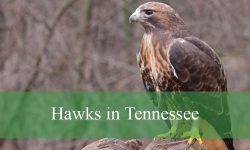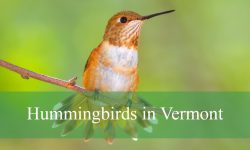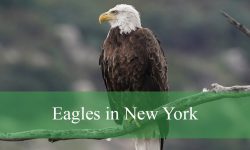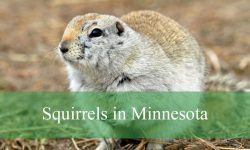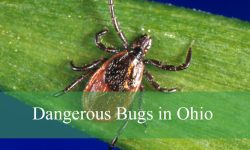Virginia is home to a wide variety of birds, from bright songbirds to impressive raptors. Whether in forests, wetlands, or suburban areas, these birds add color and life to the landscape. Observing their behaviors and calls can be a rewarding experience for both beginners and experienced birdwatchers.
This guide highlights 48 common birds in Virginia, providing details on their appearance, habitats, and distinctive traits. With this information, you can better identify the birds you see and gain a deeper appreciation for the state’s rich avian diversity.
Most Common Birds Found in Virginia
Northern Cardinal
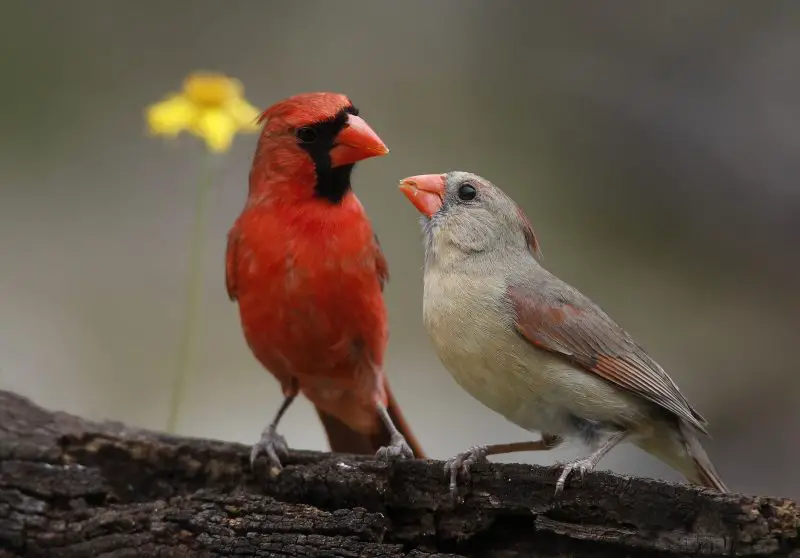
The Northern Cardinal is one of the most recognizable birds in Virginia, easily identified by its striking red plumage in males and warm brown tones with subtle red highlights in females. Both sexes have a prominent crest atop their heads and a short, thick orange-red beak that stands out vividly. Their strong, clear whistles are common in backyards, making them a favorite among birdwatchers.
Cardinals measure about 8 to 9 inches in length with a wingspan ranging from 10 to 12 inches. They are medium-sized songbirds with a stout body and long tail. Males are especially bold in color, which helps in territorial defense, while females’ more muted tones allow them to remain better camouflaged while nesting.
In Virginia, Northern Cardinals thrive in a variety of habitats including woodlands, suburban gardens, and city parks. They prefer areas with dense shrubs and thickets where they can nest and forage for seeds, berries, and insects. Because of their adaptability, they are present year-round and are even the state bird of Virginia.
American Robin
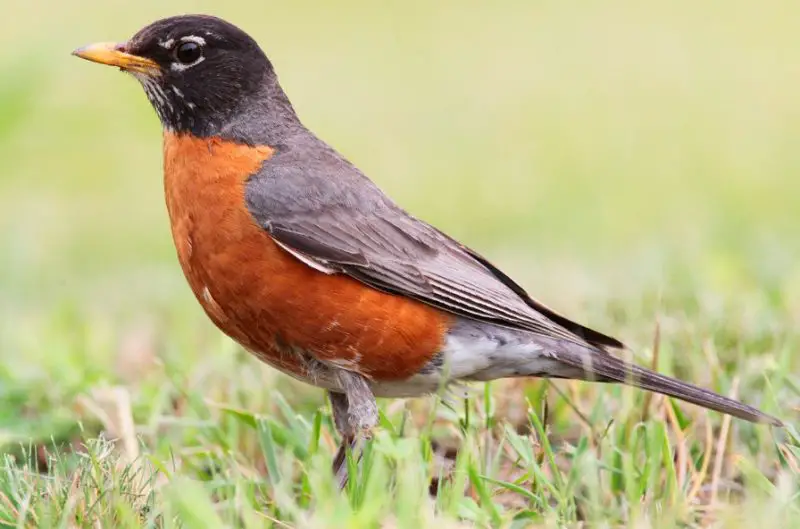
The American Robin is a familiar sight across Virginia, especially in spring when its cheerful song announces the changing season. Robins are medium-sized thrushes, typically identified by their warm orange-red breast, gray-brown back, and a white underside. Their rounded body and upright posture make them easy to recognize as they hop across lawns in search of food.
These birds measure about 9 to 11 inches long with wingspans of 12 to 16 inches. Males and females look similar, though males usually have richer coloration. Their behavior of pulling earthworms from the ground is a common and delightful observation for many Virginians.
Robins are highly adaptable and can be found in open woodlands, fields, gardens, and residential areas. In Virginia, they are common year-round but more abundant in the warmer months. They are known for building nests of mud and grass in trees, shrubs, or even on man-made structures, making them a constant presence in both wild and urban landscapes.
Blue Jay
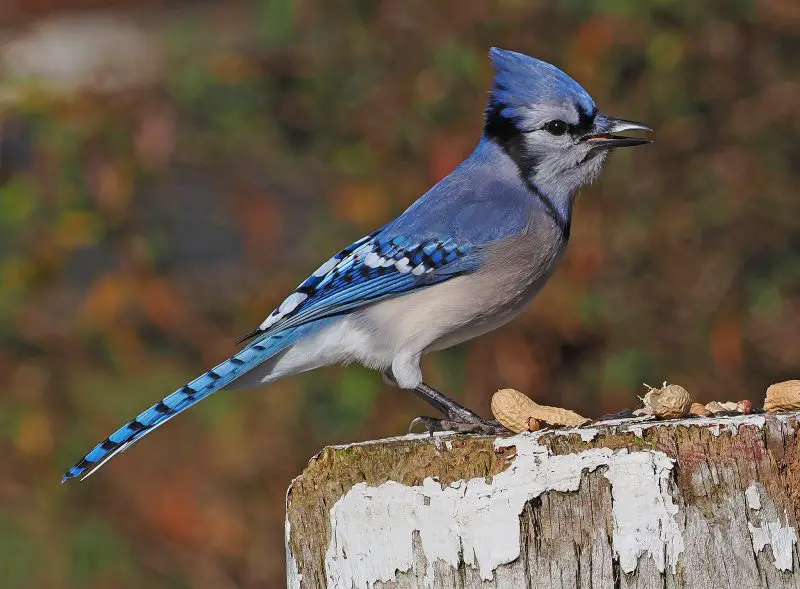
The Blue Jay is one of Virginia’s most vibrant and intelligent birds, easily identified by its bright blue plumage accented with black and white patterns. Its distinctive crest, sturdy black bill, and loud calls make it both striking in appearance and hard to miss. Blue Jays are excellent mimics and can even imitate the calls of hawks.
Measuring about 10 to 12 inches in length with wingspans of 13 to 17 inches, Blue Jays are larger than many backyard songbirds. Their strong flight and social behavior make them noticeable in both solitary and flock settings. These birds are known for their curiosity and boldness, often frequenting feeders and defending their territories vigorously.
In Virginia, Blue Jays inhabit forests, woodlands, and suburban neighborhoods. They prefer areas with oak trees since acorns are a major food source, but they also eat insects, seeds, and fruits. Active year-round, they are important seed dispersers and play a key role in the ecosystem while also being a delight for bird enthusiasts.
Carolina Wren
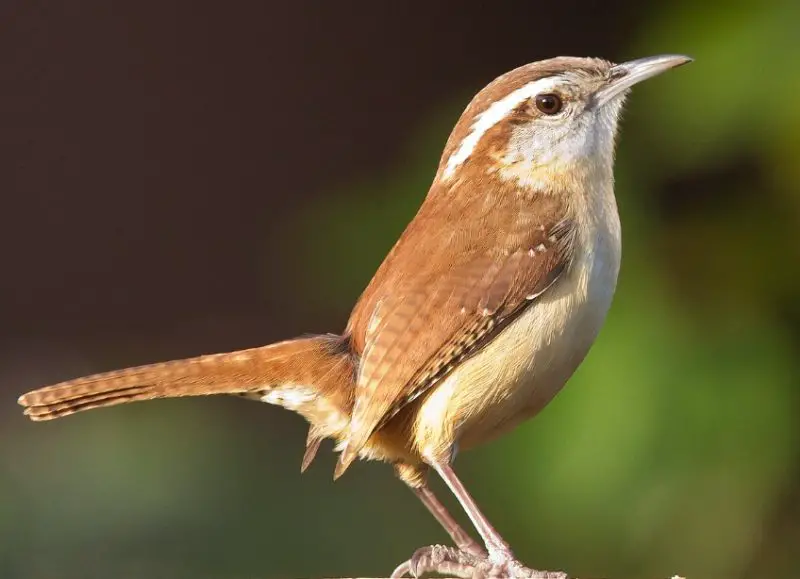
The Carolina Wren is a small but energetic bird commonly found in Virginia’s woodlands, thickets, and residential gardens. It is easily identified by its rich reddish-brown plumage, long upward-tilted tail, and a bold white eyebrow stripe that runs from the beak to the back of the head. Its loud, ringing song is often heard before the bird is seen.
Carolina Wrens are compact, measuring about 4.7 to 5.5 inches in length with wingspans of around 11 inches. Despite their small size, they have strong personalities and will vigorously defend their nesting areas. Their rounded body and slightly curved bill make them well-suited for probing bark and leaf litter in search of insects and spiders.
In Virginia, Carolina Wrens are permanent residents and can be spotted throughout the year. They favor habitats with dense vegetation and brushy areas that provide both food and cover. They are also frequent visitors to birdhouses and feeders, especially in winter when natural food becomes scarce, making them a familiar presence in many backyards.
Tufted Titmouse
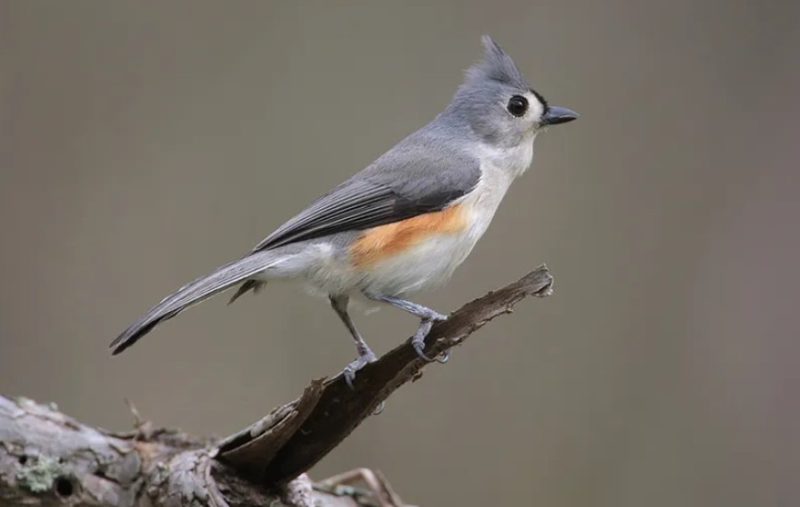
The Tufted Titmouse is a small, charming bird widely distributed across Virginia’s woodlands and suburban areas. It is easily identified by its soft gray plumage, large black eyes, and the prominent gray crest atop its head. Its pale underparts are accented with a wash of peach along the flanks, giving it a delicate yet distinctive look.
Measuring about 5.5 to 6.3 inches long with a wingspan of 7.9 to 10.2 inches, the Tufted Titmouse is slightly larger than a chickadee but shares similar behavior. They are active and agile, often seen flitting between branches or hanging upside down to extract insects. Their clear whistled “peter-peter-peter” song is a common sound in Virginia woodlands.
These birds thrive in deciduous and mixed forests but are equally comfortable in parks and backyard feeders. They feed on insects, seeds, and nuts, frequently caching food for later use. In Virginia, they are year-round residents and often form small flocks with chickadees and nuthatches, adding liveliness to the local bird community.
Mourning Dove

The Mourning Dove is a graceful and gentle bird commonly seen across Virginia in open fields, farmlands, and suburban settings. It is recognized by its slender body, long pointed tail with white edges, and soft gray-brown plumage with black spots on the wings. Its mournful, cooing call gives the species its name and is a familiar sound throughout the state.
Mourning Doves measure about 9 to 13 inches long with wingspans ranging from 17 to 18 inches. They are fast and agile fliers, capable of reaching speeds up to 55 miles per hour. Their small heads, slender bills, and plump bodies give them a distinctive silhouette when perched on wires or foraging on the ground.
In Virginia, Mourning Doves are year-round residents and are particularly abundant in rural areas with open landscapes. They feed primarily on seeds, often gathering in flocks to forage. Their adaptability allows them to thrive in both natural and human-altered environments, making them one of the most widespread and commonly observed birds in the region.
American Goldfinch
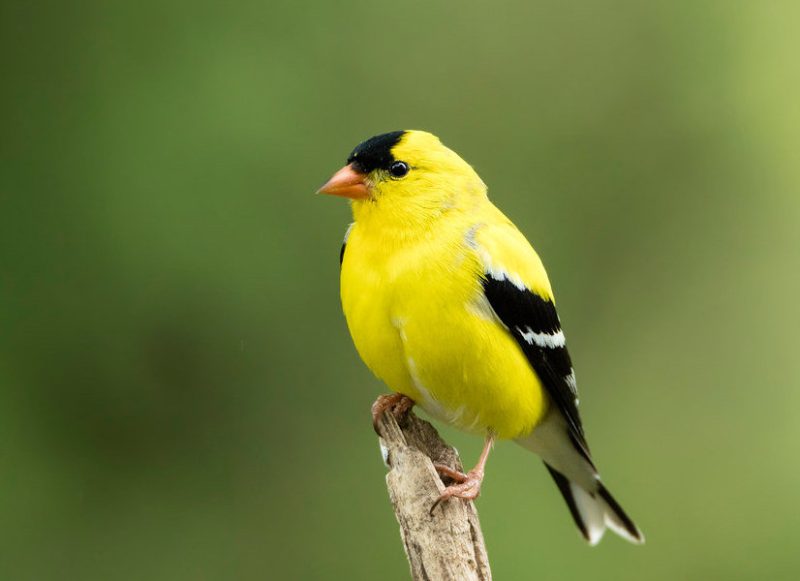
The American Goldfinch is a bright and lively bird often seen in Virginia’s meadows, fields, and backyards. Males are especially striking in summer, with their brilliant yellow plumage contrasted by black wings and a black cap, while females are more subdued with olive-yellow tones. In winter, both sexes molt into a duller brownish color, making them less conspicuous but still identifiable by their conical bills and wing patterns.
These finches are small birds, measuring about 4.3 to 5.1 inches in length with a wingspan of 7.5 to 8.7 inches. They have a bouncy flight pattern and a sweet, melodic song that adds cheer to open landscapes. Their slender bodies and short tails give them a delicate appearance, often enhanced by their habit of feeding while perched on swaying flower heads.
In Virginia, American Goldfinches are year-round residents, though they are more noticeable in summer when their colors are at their brightest. They feed primarily on seeds, particularly from thistles, sunflowers, and other weedy plants. They often gather in small flocks and are common visitors to backyard feeders, especially those stocked with nyjer seed.
Downy Woodpecker
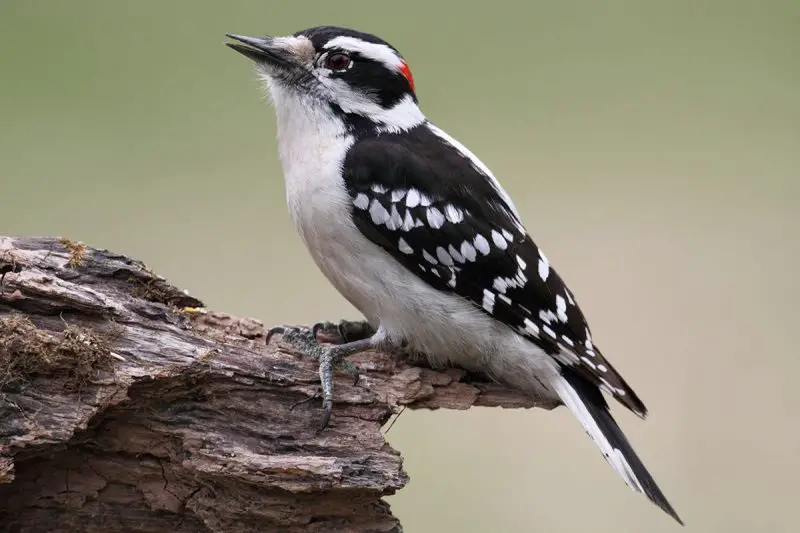
The Downy Woodpecker is the smallest woodpecker in Virginia, making it a frequent and familiar visitor to both woodlands and suburban feeders. It can be recognized by its black-and-white plumage, with a white underside, checkered wings, and a distinctive white patch on its back. Males have a small red patch on the back of the head, while females do not.
This woodpecker measures about 5.5 to 6.7 inches in length with wingspans of 9.8 to 11.8 inches. Despite its small size, the Downy Woodpecker is energetic and often seen clinging to tree trunks or thin branches, probing for insects. Its short bill is proportionally smaller than that of other woodpeckers, which helps distinguish it from the similar-looking Hairy Woodpecker.
In Virginia, Downy Woodpeckers are year-round residents found in forests, parks, orchards, and backyards. They feed on insects, larvae, seeds, and suet, making them frequent visitors to bird feeders. Their adaptability and charming behavior make them a common and well-loved presence throughout the state.
Red-bellied Woodpecker

The Red-bellied Woodpecker is a striking bird of Virginia’s forests and suburban areas, known for its bold black-and-white barred back and the bright red cap that extends from the forehead to the nape. Despite its name, the red on its belly is often faint and not always easy to see. Its loud rolling calls and drumming on tree trunks are often heard before the bird itself is spotted.
These medium-sized woodpeckers measure about 9 to 10.5 inches in length with wingspans of 13 to 16.5 inches. Males and females both display the red cap, though it is usually more extensive in males. Their sturdy bills and strong feet make them well-suited for climbing trees and excavating cavities for nests.
In Virginia, Red-bellied Woodpeckers are permanent residents and thrive in mixed forests, wooded suburbs, and even city parks. They have a varied diet that includes insects, nuts, seeds, and fruits, and they are also frequent visitors to suet feeders. Their adaptability and striking appearance make them one of the most easily recognized woodpeckers in the region.
Eastern Bluebird
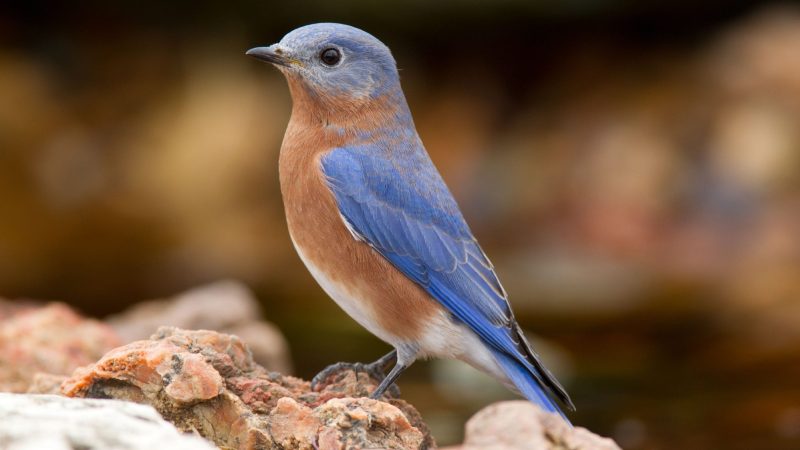
The Eastern Bluebird is one of Virginia’s most beloved birds, admired for its brilliant plumage and gentle presence. Males are especially vibrant, with bright blue backs and wings contrasted by a rusty-red chest, while females display softer shades of blue and brown. Their sweet, warbling song is a familiar sound in open fields and meadows.
Eastern Bluebirds are medium-sized songbirds, measuring about 6.3 to 8.3 inches in length with wingspans of 9.8 to 12.6 inches. Their compact bodies, rounded heads, and short bills give them a graceful profile. They are cavity nesters and readily use birdhouses, which has helped their populations remain stable.
In Virginia, Eastern Bluebirds can be found year-round, especially in open country with scattered trees, orchards, and pastures. They primarily feed on insects in the warmer months and switch to berries in the winter. Their preference for nesting boxes has made them popular with homeowners and conservation groups who actively support their presence.
House Finch
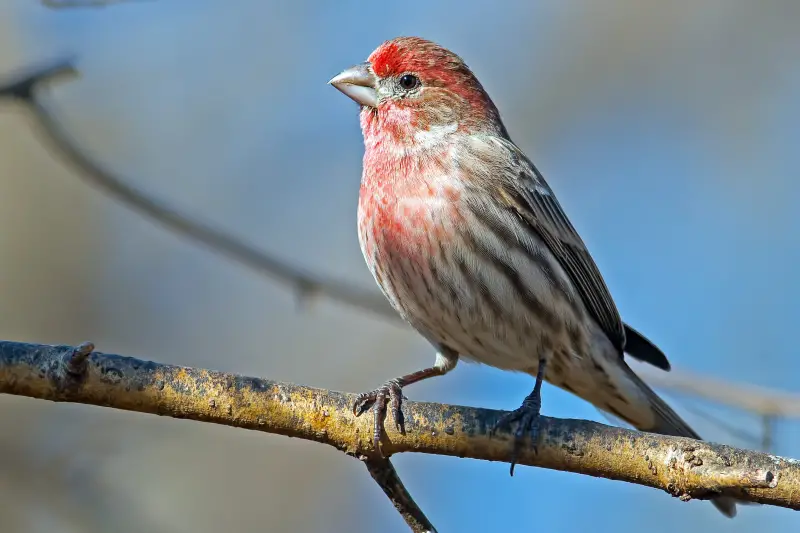
The House Finch is a small and cheerful bird commonly seen across Virginia’s towns, suburbs, and rural landscapes. Males are easily identified by their red foreheads, throats, and chests, while females are streaky brown without the red coloring. Both sexes have conical beaks suited for seed eating and long, notched tails.
These finches measure about 5 to 6 inches in length with wingspans of 8 to 10 inches. Their cheerful warbling songs and lively behavior make them popular backyard visitors. Males often sing from high perches to defend territory and attract mates, adding music to suburban neighborhoods.
House Finches are year-round residents in Virginia and thrive in a variety of habitats including gardens, parks, and urban areas. They feed mainly on seeds, fruits, and buds, often gathering in flocks. Because they are highly adaptable and comfortable around people, they are among the most commonly observed birds in the state.
White-breasted Nuthatch
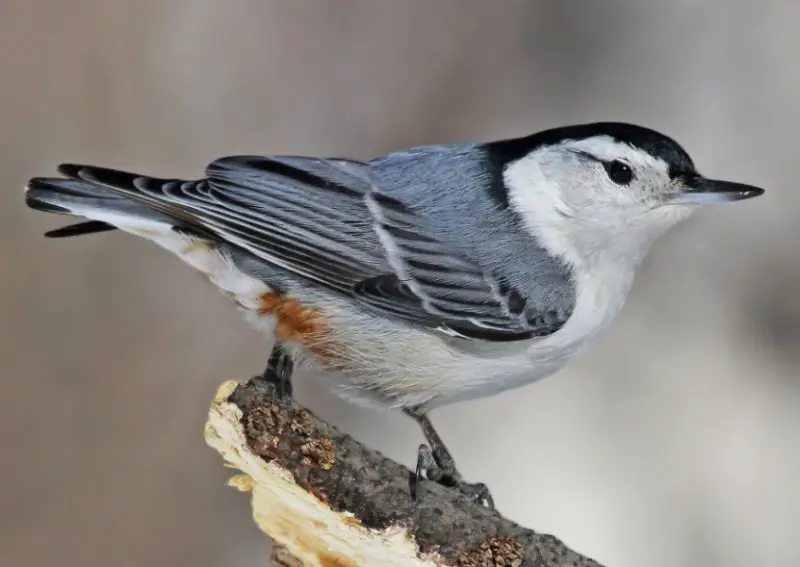
The White-breasted Nuthatch is a distinctive bird found throughout Virginia’s forests and wooded areas. It is recognized by its white face and underparts, contrasting with a blue-gray back and a black cap that extends down the nape. Its habit of creeping headfirst down tree trunks makes it particularly easy to identify.
These birds measure about 5 to 5.5 inches in length with wingspans of 8 to 10.5 inches. They have short tails, strong bills, and sturdy feet that allow them to cling effortlessly to bark while searching for insects and seeds. Their nasal “yank-yank” calls are a familiar sound in woodlands.
In Virginia, White-breasted Nuthatches are permanent residents that prefer mature forests, wooded parks, and suburban areas with large trees. They feed on insects during the summer and rely heavily on seeds and nuts in winter, often caching food in bark crevices. Their year-round activity and acrobatic movements make them a delightful bird to observe.
Eastern Towhee
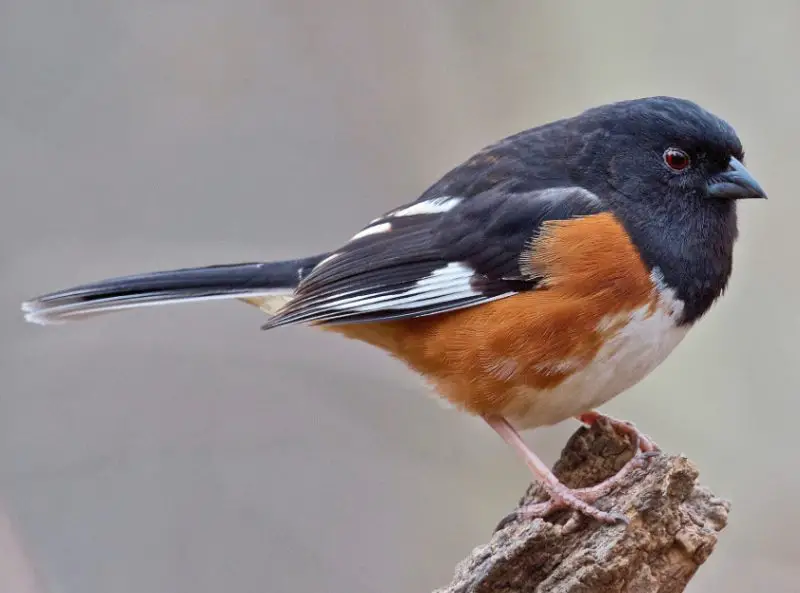
The Eastern Towhee is a striking songbird often found in Virginia’s brushy areas, forest edges, and overgrown fields. Males are boldly patterned with black upperparts, a rufous-red flank, and a white belly, while females display the same markings in brown tones instead of black. Their loud “drink-your-tea” song is one of the most recognizable calls heard in the undergrowth.
These birds measure about 6.8 to 8.2 inches long with wingspans of 7.9 to 11 inches. They have a robust body, long tail, and short, conical bill designed for seed eating. Towhees are ground-foraging birds, frequently scratching through leaf litter with a double-footed hop in search of insects and seeds.
In Virginia, Eastern Towhees are year-round residents, though their numbers are higher in warmer months. They prefer habitats with dense shrubs and tangles where they can hide and nest. Their bold plumage and strong, clear song make them stand out, even though they spend much of their time near the ground in thick cover.
Song Sparrow
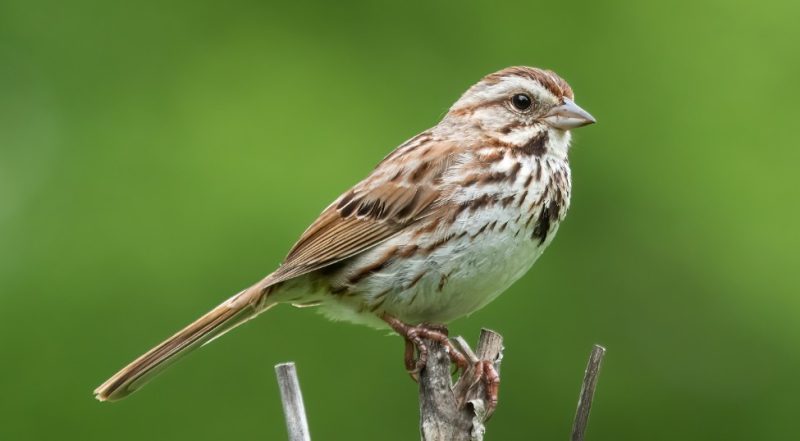
The Song Sparrow is one of the most widespread and familiar birds across Virginia. It is easily recognized by its streaky brown plumage and distinctive dark spot at the center of its breast. Its face is marked with gray and brown stripes, giving it a finely patterned appearance. True to its name, the Song Sparrow delivers a rich, melodic song that varies among individuals.
These sparrows measure about 4.7 to 6.7 inches in length with wingspans of 7.1 to 9.4 inches. They have a rounded head, long tail, and a sturdy conical bill suited for cracking seeds. While not as brightly colored as some species, their intricate plumage provides excellent camouflage in grassy and brushy habitats.
Song Sparrows are year-round residents in Virginia and can be found in fields, gardens, marshes, and woodland edges. They feed on seeds and insects, adjusting their diet with the seasons. Their adaptability and persistent singing, even in colder months, make them one of the most easily heard and recognized sparrows in the state.
Northern Mockingbird
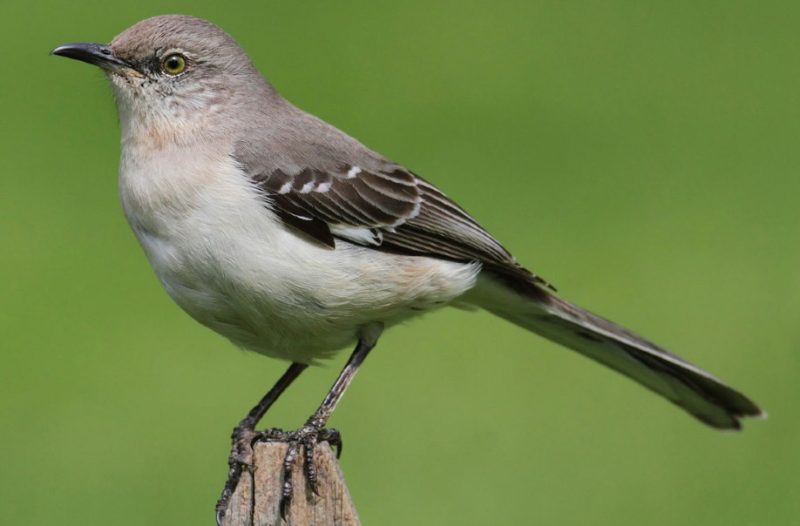
The Northern Mockingbird is a familiar bird in Virginia, celebrated for its extraordinary ability to mimic the songs of other birds and even mechanical noises. It is medium-sized with gray upperparts, a paler underside, and striking white wing patches that flash brightly in flight. Its long tail and slender build give it a graceful appearance.
Mockingbirds measure about 8 to 10 inches long with wingspans of 12 to 15 inches. They are bold and territorial, often singing loudly from high perches during the day and sometimes even at night. Their vocal repertoire can include dozens of different imitations, making them one of the most talented songbirds in North America.
In Virginia, Northern Mockingbirds are permanent residents and are especially common in suburban areas, open woodlands, and parks. They feed on insects during summer and switch to berries and fruits in winter. Their adaptability and lively presence make them a constant feature of both wild and urban environments.
American Crow
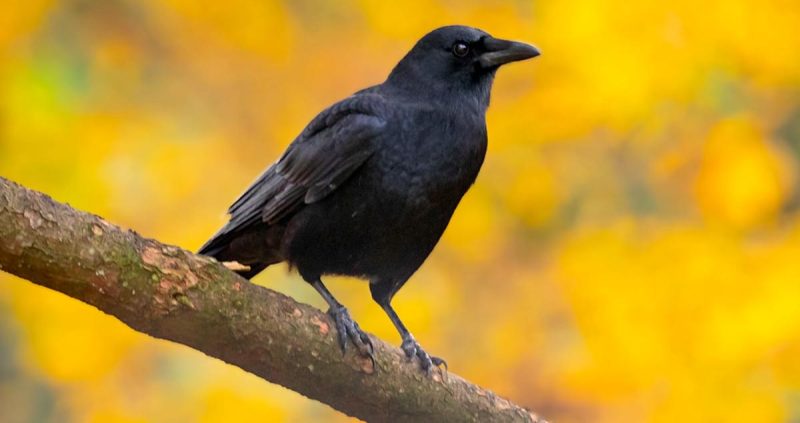
The American Crow is one of Virginia’s most intelligent and adaptable birds, often seen in fields, forests, and urban settings. Its glossy black plumage, stout bill, and loud “caw” call make it easy to identify. Though often mistaken for ravens, crows are smaller and have squared-off tails rather than wedge-shaped ones.
These birds measure about 16 to 20 inches in length with wingspans ranging from 33 to 39 inches. They are highly social and often gather in large flocks, especially in winter. Their strong flight, problem-solving skills, and ability to use tools have made them famous for intelligence and adaptability.
In Virginia, American Crows are year-round residents and thrive in nearly every habitat, from farmlands to city streets. They are opportunistic feeders, eating insects, seeds, carrion, and even garbage in urban areas. Their adaptability and intelligence allow them to coexist closely with people, making them one of the most frequently observed large birds in the state.
Carolina Chickadee
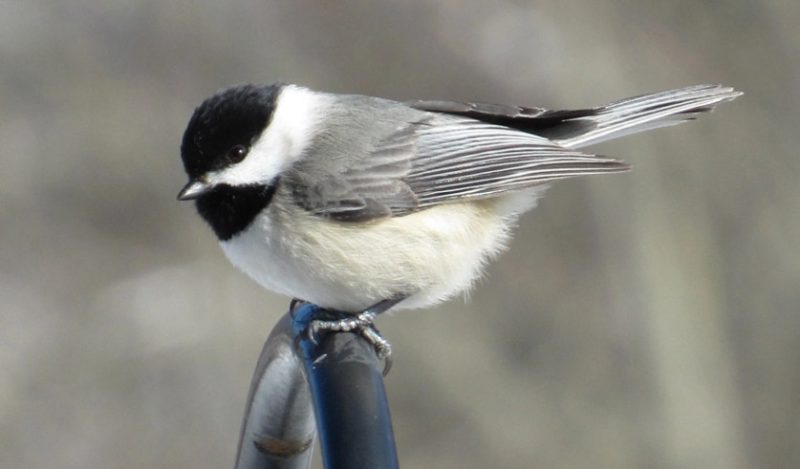
The Carolina Chickadee is a small, energetic bird found throughout Virginia’s woodlands, parks, and backyards. It has a distinctive appearance with a black cap and bib, white cheeks, and soft gray upperparts. Its cheerful “chick-a-dee-dee-dee” call is one of the most familiar sounds in the region.
These birds measure about 3.9 to 4.7 inches long with wingspans of 5.9 to 7.9 inches. Despite their small size, they are highly active and agile, often hanging upside down as they forage for insects and seeds. Their rounded body and short bill make them resemble the closely related Black-capped Chickadee, though they are separate species.
In Virginia, Carolina Chickadees are year-round residents that favor deciduous and mixed forests as well as suburban areas with mature trees. They frequently visit bird feeders, especially in winter, and often form mixed-species flocks with titmice and nuthatches. Their bold personality and constant activity make them a delight for backyard birdwatchers.
Great Blue Heron
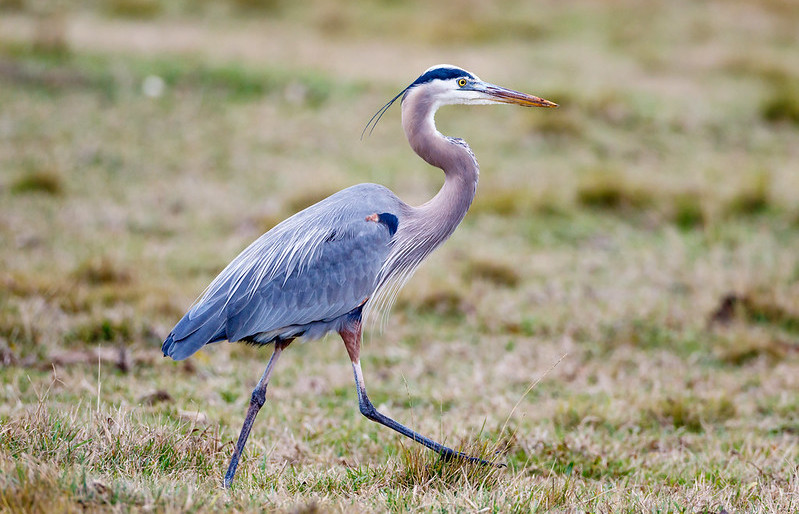
The Great Blue Heron is the largest heron in Virginia, easily recognized by its tall stature, long neck, and gray-blue plumage. It has a dagger-like bill, black plumes on its head, and long legs perfectly suited for wading in shallow waters. Its slow, deliberate wingbeats and folded neck in flight make it a majestic sight over wetlands.
These birds stand about 3.2 to 4.5 feet tall, with wingspans reaching up to 6.5 feet. Despite their size, they are graceful hunters, moving slowly through marshes and riversides before striking swiftly at fish with their sharp bills. They also feed on amphibians, reptiles, insects, and even small mammals.
In Virginia, Great Blue Herons are commonly seen along rivers, lakes, ponds, and coastal areas. They are present year-round, often nesting in colonies called rookeries high in trees near water. Their impressive size, elegant posture, and patient hunting style make them one of the most iconic waterbirds in the state.
Turkey Vulture
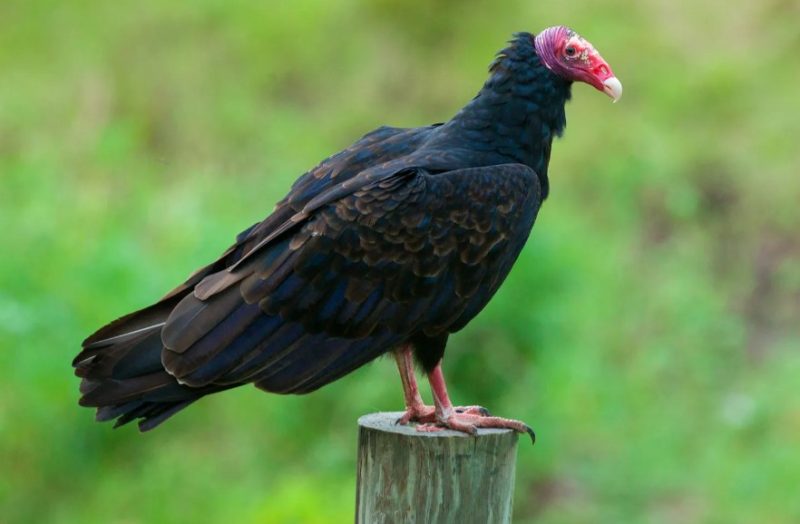
The Turkey Vulture is a large soaring bird often seen gliding over open landscapes in Virginia. It is easily recognized by its dark brown to black body, long broad wings with silver-gray undersides, and a small, bare red head that helps keep it clean while feeding. Its characteristic teetering flight, with wings held in a shallow V-shape, makes it easy to distinguish from other large birds.
These birds measure about 25 to 32 inches in length with impressive wingspans of up to 6 feet. Unlike hawks and eagles, they rarely flap their wings for long, instead using thermal air currents to soar gracefully while searching for carrion. Their keen sense of smell, rare among birds, allows them to locate food from great distances.
In Virginia, Turkey Vultures are common year-round, often found in farmlands, forests, and roadsides. They play a vital ecological role by cleaning up carcasses, reducing the spread of disease. Despite their somewhat eerie reputation, they are harmless to living creatures and are an essential part of the natural environment.
Canada Goose
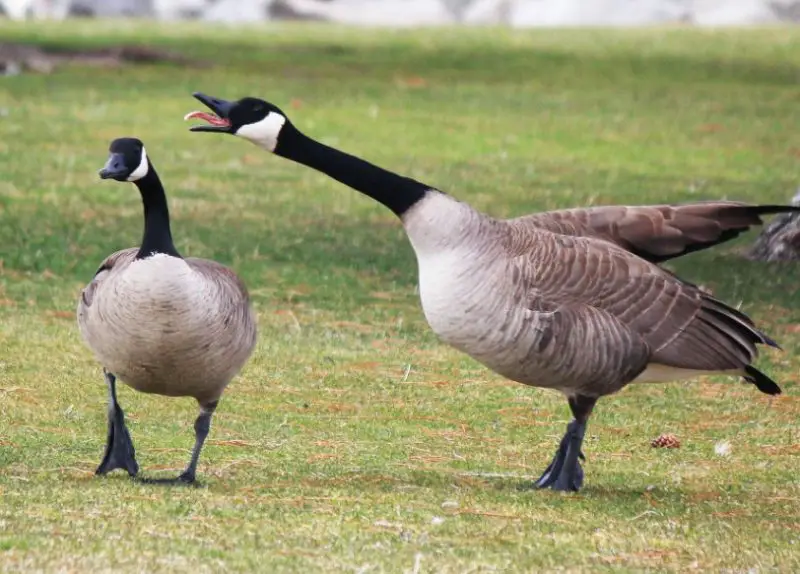
The Canada Goose is one of the most familiar waterfowl in Virginia, often seen in lakes, rivers, wetlands, and even urban parks. It is easily identified by its black head and neck, striking white cheek patch, and brownish-gray body. Its honking calls are a familiar sound, especially when flocks migrate in their iconic V-shaped formations.
These geese are large birds, measuring 30 to 43 inches in length with wingspans ranging from 50 to 70 inches. They are strong fliers and highly social, often staying in family groups and large flocks throughout the year. Their distinctive flight formations help conserve energy and maintain communication during migration.
In Virginia, Canada Geese are both migratory and resident, with many populations staying year-round due to abundant food and open water. They feed on grasses, grains, and aquatic plants, frequently grazing in fields and lawns. Their adaptability to human environments has made them common in suburban areas, where they are both admired and sometimes considered a nuisance.
Red-winged Blackbird
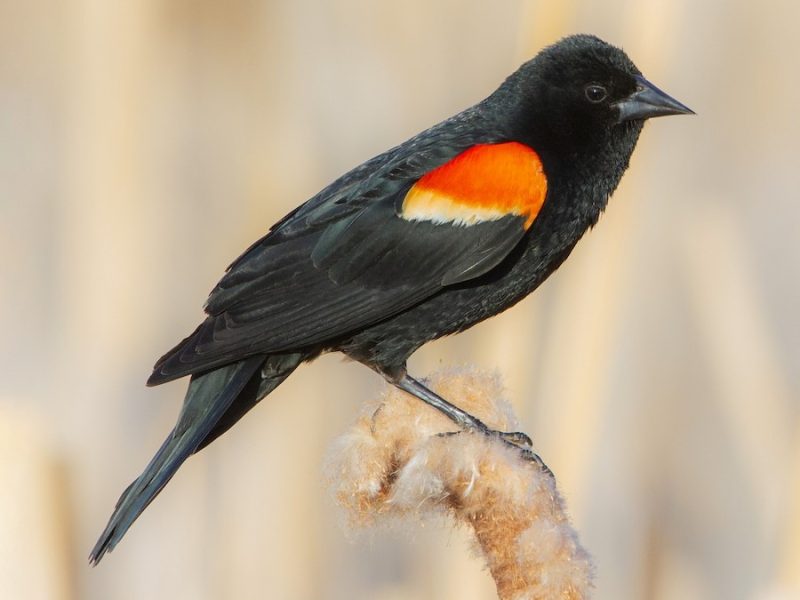
The Red-winged Blackbird is one of Virginia’s most striking and widespread songbirds, commonly found in wetlands, marshes, and open fields. Males are easily identified by their glossy black feathers and bright red shoulder patches edged with yellow, while females are streaky brown and resemble sparrows. Their bold “conk-la-ree” song is a familiar sound in spring and summer.
These birds measure about 6.7 to 9.1 inches in length with wingspans of 12 to 15 inches. Males are highly territorial, often displaying their red shoulder patches aggressively to defend nesting areas. Females are less conspicuous, blending into their surroundings as they tend to hidden nests among reeds and grasses.
In Virginia, Red-winged Blackbirds are common year-round but are most abundant in breeding season. They feed on a variety of insects, seeds, and grains, often foraging in large flocks. Their vibrant presence and distinctive calls make them one of the most easily recognized blackbirds in the state.
Common Grackle
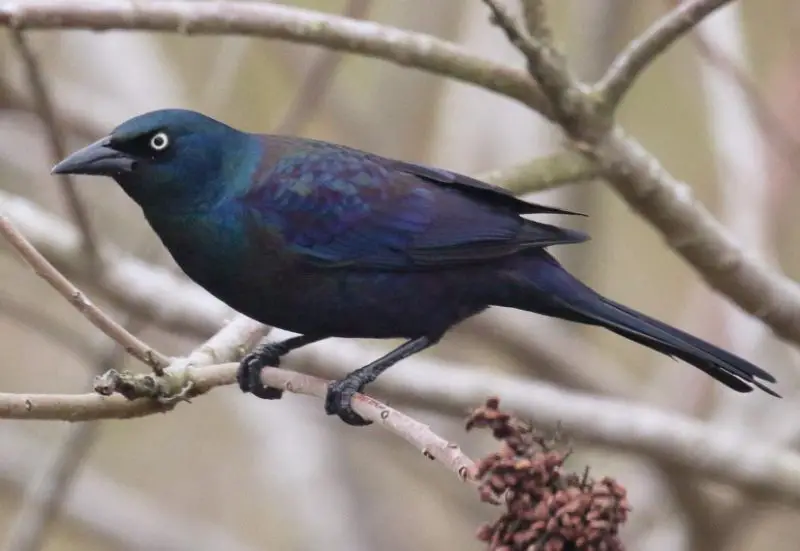
The Common Grackle is a bold and noisy bird found across Virginia in open fields, woodlands, and urban areas. It is identified by its iridescent black plumage that can shine with hints of purple, green, and bronze in sunlight. Its long keel-shaped tail, pale yellow eyes, and upright stance give it a distinctive look compared to other blackbirds.
These birds measure about 11 to 13 inches in length with wingspans of 14 to 18 inches. They are strong and confident foragers, often walking across lawns or fields in search of insects, seeds, and grains. Their loud, metallic calls and tendency to gather in large flocks make them highly noticeable.
In Virginia, Common Grackles are year-round residents and are often seen in large mixed flocks with blackbirds and starlings. While sometimes considered agricultural pests due to crop feeding, they are an important part of the ecosystem, controlling insect populations. Their shimmering plumage and social behavior make them both fascinating and unmistakable.
European Starling
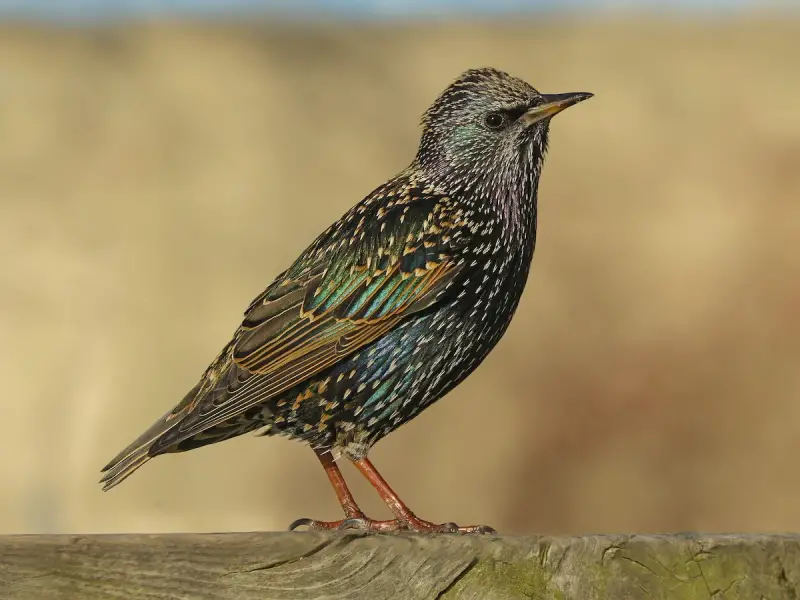
The European Starling is a widespread bird in Virginia, introduced from Europe in the 19th century and now thriving across the continent. It is recognized by its glossy black plumage that shines with purple and green iridescence, especially in breeding season. In winter, its feathers are speckled with white, giving it a spotted appearance.
Starlings measure about 7.9 to 9.1 inches in length with wingspans of 12 to 16 inches. They have short tails, pointed wings, and strong, direct flight. Known for their vocal versatility, they can mimic other birds and even mechanical sounds, making them highly adaptable songsters.
In Virginia, European Starlings are year-round residents, thriving in both rural and urban settings. They often form massive flocks called murmurations, creating breathtaking aerial displays at dusk. Although sometimes regarded as invasive due to their aggressive competition with native species, they remain one of the most abundant and easily observed birds in the region.
Barn Swallow
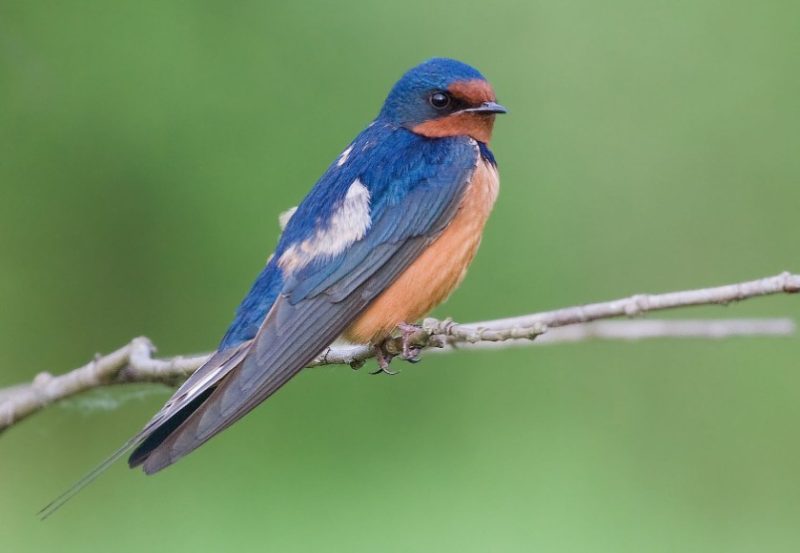
The Barn Swallow is a graceful and agile bird often seen darting through the skies of Virginia in pursuit of flying insects. It is easily identified by its long forked tail, sleek blue upperparts, and reddish-orange throat and forehead. Its elegant flight and chattering calls make it one of the most beloved summer birds.
These swallows measure about 5.9 to 7.5 inches long with wingspans of 11.4 to 12.6 inches. They have streamlined bodies and long pointed wings, making them exceptionally skilled aerial hunters. Their deeply forked tails not only aid in maneuverability but also add to their striking appearance in flight.
In Virginia, Barn Swallows are summer breeders, arriving in spring and leaving for South America in fall. They commonly nest under barns, bridges, and other structures, building mud cup nests that shelter their young. Their presence is a welcome sign of warm weather, and their insect-catching habits make them beneficial companions for farmers and homeowners alike.
Chimney Swift
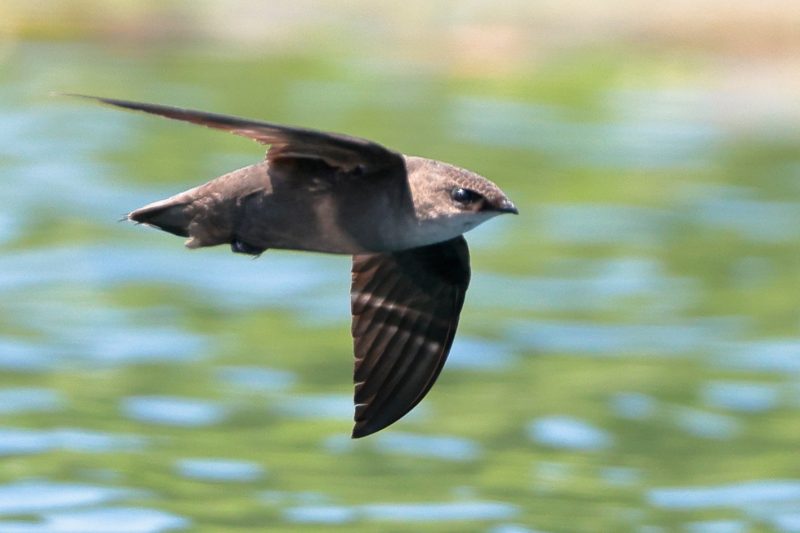
The Chimney Swift is a small, slender bird known for its cigar-shaped body and long, narrow wings. Its plumage is dark grayish-brown, giving it a sooty appearance in flight. Unlike many birds, Chimney Swifts are almost never seen perching upright, as their short legs and tiny feet are adapted for clinging to vertical surfaces. They are often mistaken for bats due to their rapid, fluttering flight patterns at dusk.
In Virginia, they are a common sight in both urban and rural areas, particularly during the warmer months when they migrate north to breed. As their name suggests, they frequently nest and roost inside chimneys, old buildings, and hollow trees, using their saliva to glue twigs together for nest construction. These birds are aerial insectivores, spending nearly all of their lives in flight while feeding on flying insects.
Their behavior is highly social, often seen in flocks during migration and roosting in large numbers. They are most active during the day, filling the skies with their chattering calls as they swoop and dart after insects. Chimney Swifts are especially valuable in controlling mosquito populations, making them an important species within Virginia’s ecosystem.
Purple Martin
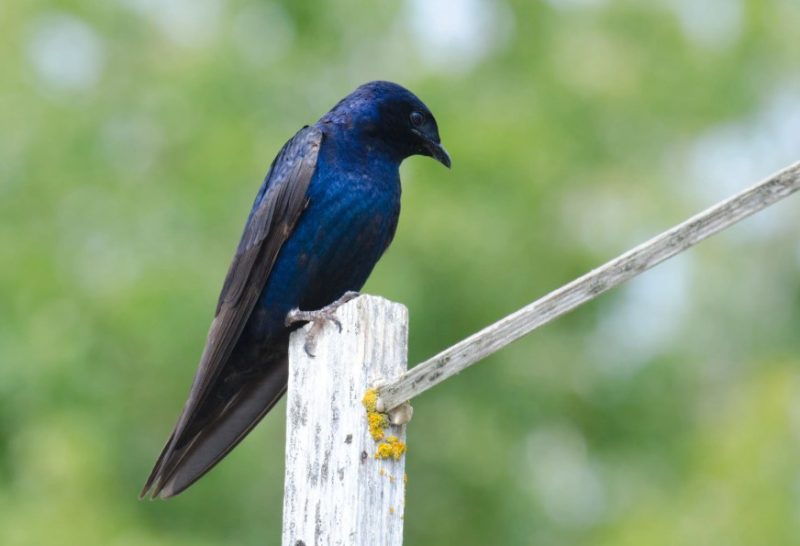
The Purple Martin is the largest swallow in North America and is easily recognized by its glossy, iridescent plumage. Adult males are deep blue-black with a shimmering purple sheen, while females and juveniles have lighter underparts with grayish tones. Their long, pointed wings and slightly forked tails give them a graceful flight, often accompanied by cheerful gurgling calls.
In Virginia, Purple Martins are common summer residents, particularly in open areas near water. They rely heavily on human-provided birdhouses and martin condos, as their natural nesting sites in tree cavities have diminished. Colonies of these birds can be found near fields, lakes, and suburban neighborhoods, where they gather to breed and raise their young.
Purple Martins are aerial feeders, catching a wide variety of insects in flight, including dragonflies, beetles, and moths. They are highly social and often roost together in large groups during migration. Their return each spring is eagerly anticipated by bird enthusiasts across Virginia, as they symbolize the arrival of warmer weather.
Tree Swallow
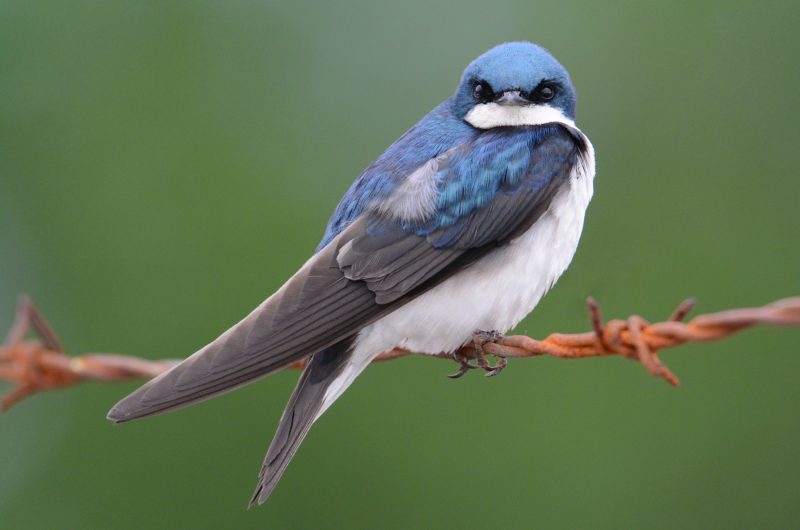
The Tree Swallow is a small, sleek bird with iridescent blue-green upperparts and pure white underparts. Their pointed wings and slightly forked tails make them agile fliers, perfectly adapted for chasing insects in midair. Both males and females share similar plumage, though males tend to appear glossier in the sunlight.
These swallows are widespread across Virginia, particularly in open habitats such as fields, wetlands, and near bodies of water. They nest in tree cavities or nest boxes, making them common visitors to areas where people install bluebird boxes. Their arrival in early spring often precedes that of many other migratory birds, marking the change of seasons.
Tree Swallows feed primarily on flying insects, though they also eat berries, especially in colder months when insects are scarce. They are active, social birds that often form large flocks during migration. Their fluid, acrobatic flight patterns make them a joy to watch as they skim over water and fields in search of food.
Belted Kingfisher

The Belted Kingfisher is a striking bird with a large head, shaggy crest, and heavy bill. Its blue-gray plumage is accented by a white collar and a broad blue band across the chest. Females are unique in having an additional rusty-colored band across their belly, making them one of the few bird species where females are more brightly marked than males.
In Virginia, Belted Kingfishers are commonly found along rivers, lakes, ponds, and coastal waters. They are expert fishers, often seen perched on branches or wires overlooking water before diving headfirst to catch their prey. Their rattling, mechanical call is a familiar sound around aquatic habitats.
These solitary birds are territorial and often aggressive in defending their fishing grounds. They dig burrows in sandy banks or riverbanks to nest, sometimes extending as much as six feet into the earth. Their adaptability and distinct hunting style make them one of Virginia’s most recognizable waterbirds.
Pileated Woodpecker
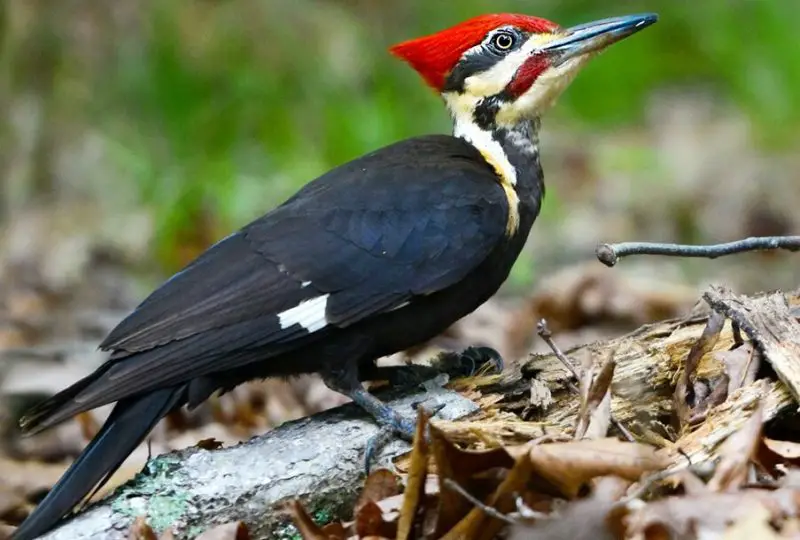
The Pileated Woodpecker is the largest woodpecker in Virginia and is instantly recognizable by its bold red crest and striking black-and-white plumage. Its size, nearly that of a crow, along with its powerful bill, allows it to carve deep rectangular holes into trees while searching for insects. The loud, resonant drumming of this species is a familiar sound in forested areas.
These woodpeckers thrive in mature forests, particularly those with large trees and decaying wood. In Virginia, they are often seen in woodlands, parks, and even suburban areas with sufficient tree cover. Their diet consists mainly of carpenter ants, beetle larvae, and other insects, though they also eat fruits and nuts.
Pileated Woodpeckers are generally shy but can be observed flying between trees with slow, deliberate wingbeats. Their distinctive “kuk-kuk-kuk” calls echo through the forest, making them easy to identify even when not in sight. As ecosystem engineers, their cavities provide homes for other wildlife, including owls, bats, and small mammals.
Hairy Woodpecker
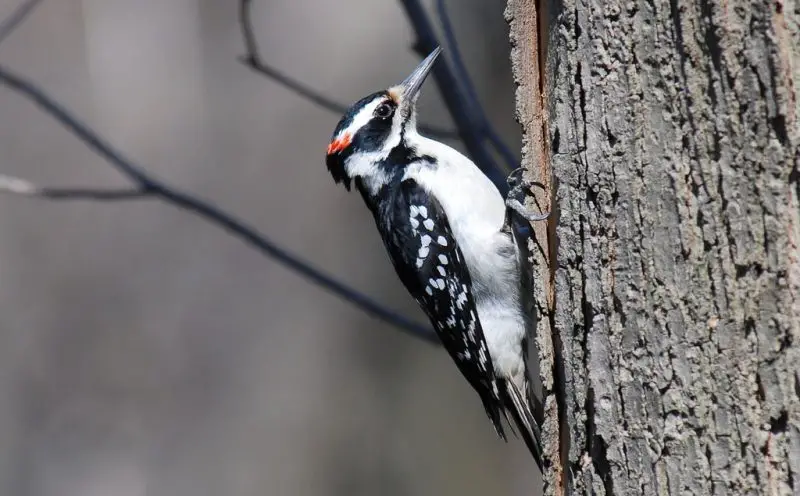
The Hairy Woodpecker is a medium-sized woodpecker with black-and-white plumage and a long, chisel-like bill. Males feature a small red patch on the back of the head, while females lack this marking. They are very similar in appearance to the Downy Woodpecker, but the Hairy has a noticeably larger bill and a slightly bigger body overall.
In Virginia, Hairy Woodpeckers are found in forests, woodlands, and residential areas with mature trees. They spend much of their time foraging on tree trunks and branches, where they pry off bark and hammer into wood to find insects. Their sharp “peek” calls and steady drumming often reveal their presence before they are seen.
These birds are solitary feeders but may join mixed flocks in winter. They play an important ecological role by controlling insect populations, especially wood-boring beetles. Their nesting cavities in dead or dying trees also provide homes for secondary cavity nesters, making them valuable contributors to forest biodiversity.
Northern Flicker
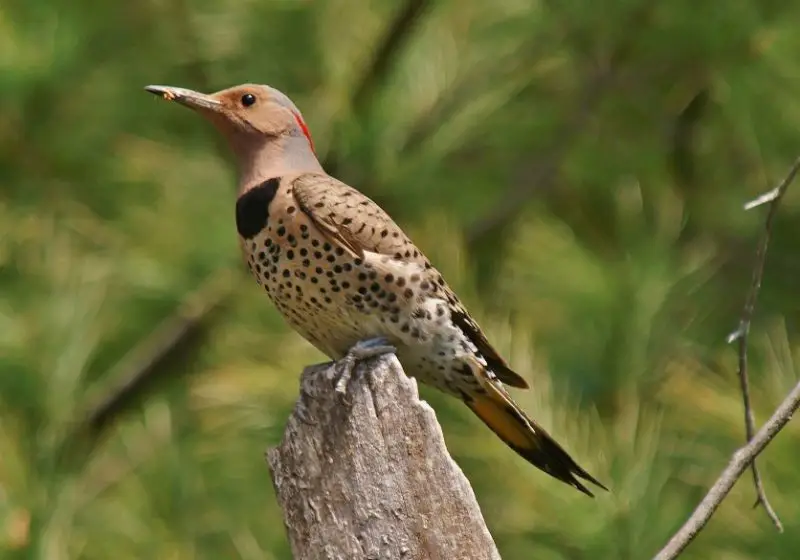
The Northern Flicker is a large, ground-feeding woodpecker with a striking appearance. Its brown plumage is patterned with black bars and spots, and it displays a bold white rump patch that is easily seen in flight. In Virginia, the eastern “yellow-shafted” variety is common, identified by its bright yellow underwing and tail feathers, along with a black crescent-shaped bib on the chest.
Unlike most woodpeckers, Northern Flickers often forage on the ground, using their slightly curved bills to dig for ants, their primary food source. They also eat beetles, fruits, and seeds. Their loud “wick-a-wick-a-wick” call and rapid drumming make them easy to detect, even from a distance.
These birds inhabit open forests, woodland edges, and suburban areas throughout Virginia. They are cavity nesters, excavating holes in dead trees or occasionally using nest boxes. With their unique feeding habits and colorful plumage, Northern Flickers are a distinctive and fascinating member of Virginia’s birdlife.
Cedar Waxwing
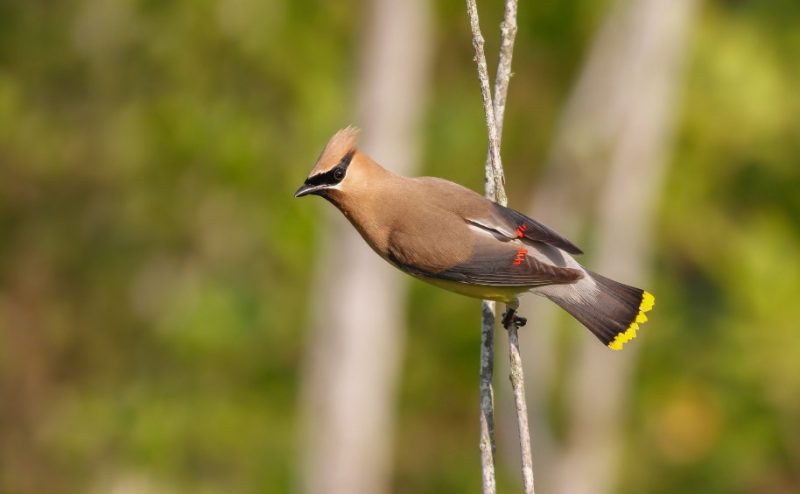
The Cedar Waxwing is a sleek, elegant bird commonly found in Virginia’s orchards, gardens, and open woodlands. It is easily recognized by its soft brown head and chest, pale yellow belly, gray wings, and distinctive black mask across the eyes. The tips of the secondary wing feathers are bright red, resembling sealing wax, which gives the bird its name, and its tail ends with a yellow band.
Cedar Waxwings measure about 6.3 to 7.1 inches in length with wingspans of 8.7 to 12 inches. They are social birds, often seen in flocks, and have a high-pitched, trilling call. Their graceful flight and gregarious behavior make them a delight to observe as they forage and interact in groups.
In Virginia, Cedar Waxwings are year-round residents in many areas but are more noticeable during migration. They feed primarily on berries and fruits, particularly in late summer and fall, but also consume insects in the warmer months. Their tendency to share food and engage in “pass-the-berry” behaviors among flock members adds charm to their social interactions.
House Sparrow
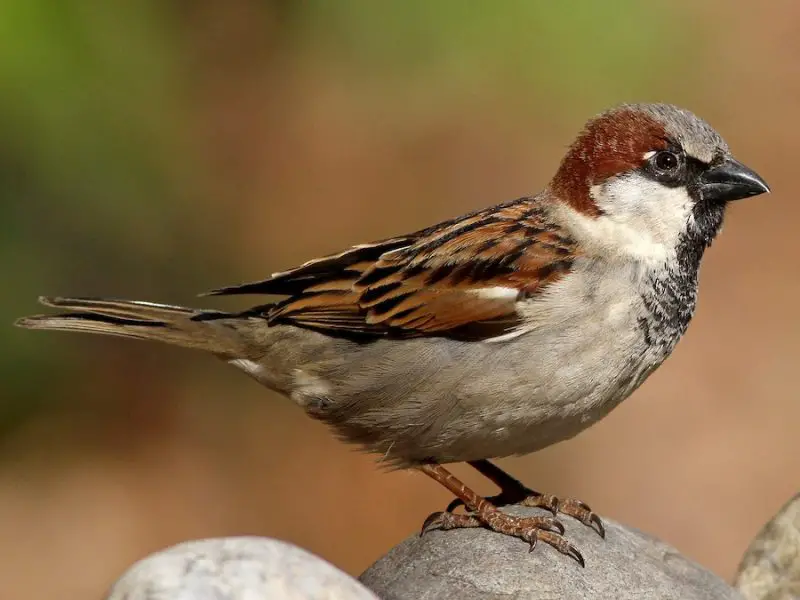
The House Sparrow is a small, hardy bird widely distributed across Virginia’s urban, suburban, and rural landscapes. Males have gray heads, chestnut-brown backs, and black bibs, while females are more uniformly brown with streaked backs and pale underparts. Their short, stout bills are well-adapted for seed eating.
These sparrows measure about 5.5 to 6.3 inches long with wingspans of 7.5 to 9.8 inches. They are active and gregarious, often found in flocks around human settlements. Their chirping calls and constant movement make them one of the most noticeable backyard birds, especially near feeders and gardens.
House Sparrows are year-round residents in Virginia and thrive in environments altered by humans. They nest in cavities, eaves, and nest boxes, often displacing native species. Their diet is diverse, including seeds, grains, insects, and scraps, which allows them to flourish in a wide range of habitats.
American Kestrel
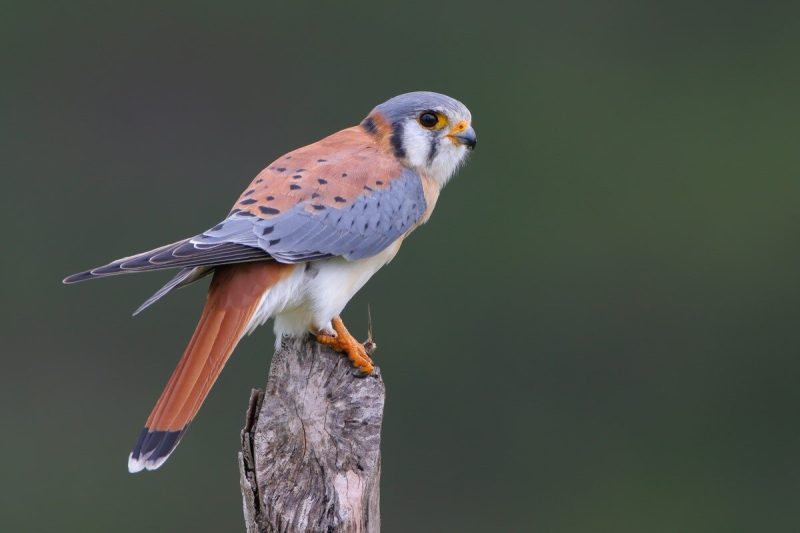
The American Kestrel is the smallest falcon in North America and a striking predator found throughout Virginia. Males have slate-blue wings and a reddish-brown back with black spotting, while females are more uniformly reddish-brown with black barring. Both sexes have a distinctive facial pattern with vertical black stripes on the face, giving them a “mustached” appearance.
Kestrels measure about 8.3 to 12.2 inches in length with wingspans of 20 to 24 inches. They are agile hunters, often seen hovering in the air while scanning for prey, including insects, small birds, and rodents. Their rapid, direct flight and sharp calls make them easily identifiable in the field.
In Virginia, American Kestrels are most commonly found in open fields, meadows, and along roadsides with scattered perches. They nest in tree cavities, cliff ledges, and artificial boxes. Their small size, bright plumage, and hunting acrobatics make them a striking sight for birdwatchers throughout the state.
Red-tailed Hawk
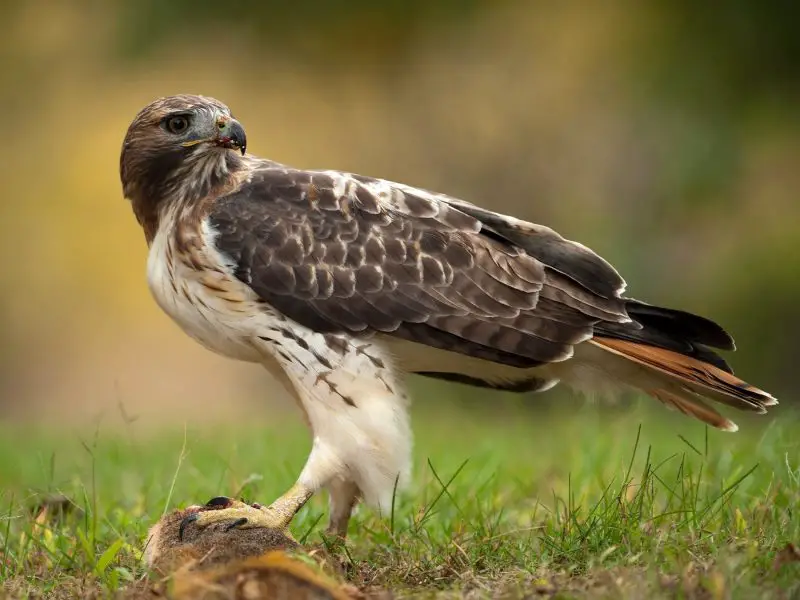
The Red-tailed Hawk is one of Virginia’s most common and iconic raptors, easily identified by its broad, rounded wings, short, wide tail, and reddish-brown tail in adults. Its plumage is variable, generally featuring a brown back, pale underparts, and a streaked belly band. Its piercing eyes and sharp beak convey the power of this top predator.
Red-tailed Hawks measure about 18 to 26 inches in length with wingspans of 43 to 57 inches. They are versatile hunters, using both soaring flight and perches to spot prey such as rodents, rabbits, birds, and reptiles. Their signature “kee-eeeee-ar” scream is often heard echoing over open landscapes.
In Virginia, Red-tailed Hawks are year-round residents, occupying forests, fields, and suburban areas. They are adaptable and can hunt successfully in a variety of habitats. Their presence plays an important role in controlling populations of small mammals and maintaining ecological balance.
Cooper’s Hawk
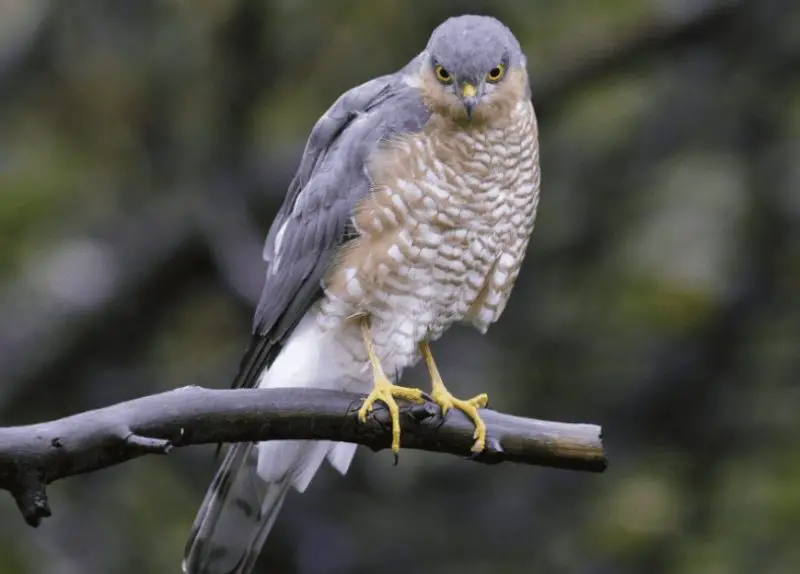
The Cooper’s Hawk is a medium-sized raptor widely found in Virginia, especially in woodlands, suburban neighborhoods, and areas near bird feeders. Adults have blue-gray upperparts, reddish barring on the chest, and a long tail with dark bands. Juveniles are brown above with streaked underparts, which helps them remain camouflaged while learning to hunt.
These hawks measure about 14 to 20 inches in length with wingspans of 24 to 35 inches. They are agile fliers, capable of maneuvering quickly through dense trees and shrubs while pursuing birds and small mammals. Their quick, direct flight and rapid wingbeats distinguish them from the more soaring raptors like Red-tailed Hawks.
In Virginia, Cooper’s Hawks are year-round residents, often nesting in tall trees near open areas where prey is abundant. They primarily feed on medium-sized birds such as doves and songbirds, making them stealthy and efficient predators. Their ability to adapt to suburban environments has made them increasingly visible to birdwatchers in populated areas.
Bald Eagle

The Bald Eagle is a majestic raptor and the national symbol of the United States, commonly found along Virginia’s rivers, lakes, and coastal areas. Adults have a striking white head and tail contrasted with dark brown body and wings, while juveniles are mostly brown with mottled white patches. Their large, hooked beaks and powerful talons make them formidable predators, and their keen eyesight allows them to spot prey from great distances.
Bald Eagles measure about 28 to 40 inches in length with wingspans of 70 to 90 inches. They soar gracefully with broad, long wings and are often seen perched near water, scanning for fish. Their loud, high-pitched whistles and occasional screeches carry across open areas, announcing their presence.
In Virginia, Bald Eagles are year-round residents along major waterways, estuaries, and large lakes. They primarily feed on fish, but also hunt birds, mammals, and scavenge carrion when necessary. Conservation efforts have helped their populations rebound, and they are now commonly seen in areas that provide both food and tall trees for nesting.
Osprey
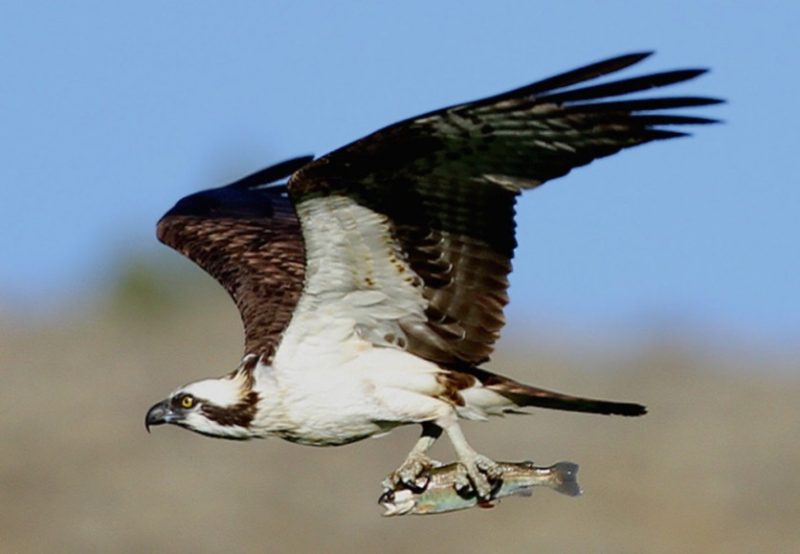
The Osprey is a large fish-eating raptor easily recognized by its white head with a dark eye stripe, brown back, and pale underparts. Its long, narrow wings give it a distinctive M-shaped silhouette in flight. Ospreys are expert hunters, capable of diving into water feet-first to capture fish with their sharp, curved talons.
Ospreys measure about 21 to 26 inches in length with wingspans of 59 to 71 inches. They are highly visible near lakes, rivers, and coastal marshes in Virginia, where they hover or circle before plunging to snatch fish. Their high-pitched, whistling calls are often heard near nesting or feeding sites.
In Virginia, Ospreys are migratory, arriving in spring to breed and raising their young in large stick nests atop platforms, poles, and treetops. They feed almost exclusively on live fish and are highly specialized for aquatic hunting. Their presence near waterways indicates healthy aquatic ecosystems and makes them a favorite among birdwatchers.
Great Horned Owl
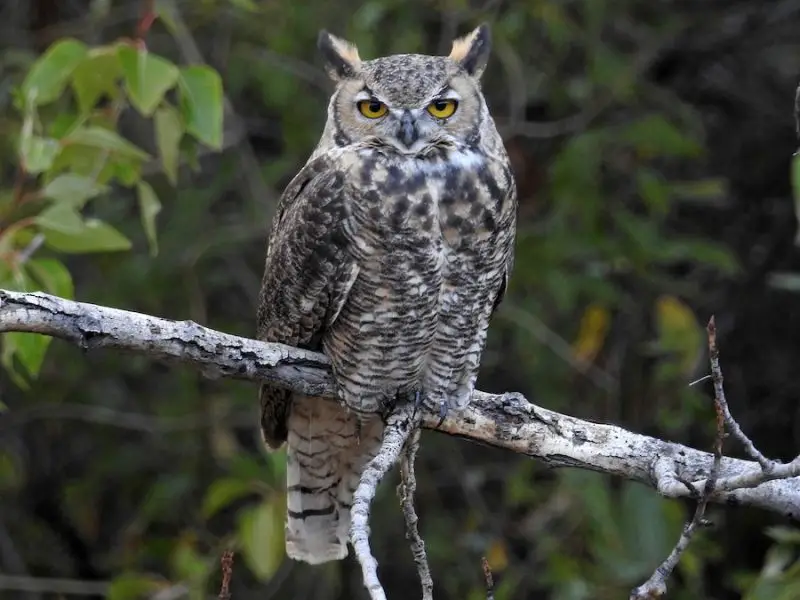
The Great Horned Owl is one of Virginia’s largest and most powerful nocturnal predators. It is easily identified by its large size, ear tufts, mottled brown and gray plumage, and piercing yellow eyes. Its silent flight and deep hoots make it a dominant presence in both forests and suburban areas.
These owls measure about 18 to 25 inches in length with wingspans of 3.3 to 4.8 feet. They are versatile hunters, preying on mammals, birds, reptiles, and even larger prey such as skunks. Their strong talons and robust bills enable them to tackle prey much larger than themselves.
Great Horned Owls are year-round residents in Virginia, inhabiting forests, swamps, and urban parks. They nest in abandoned nests of other large birds or on cliffs, and their adaptability allows them to thrive near human development. Their role as apex predators helps maintain healthy populations of smaller animals in their habitats.
Barred Owl
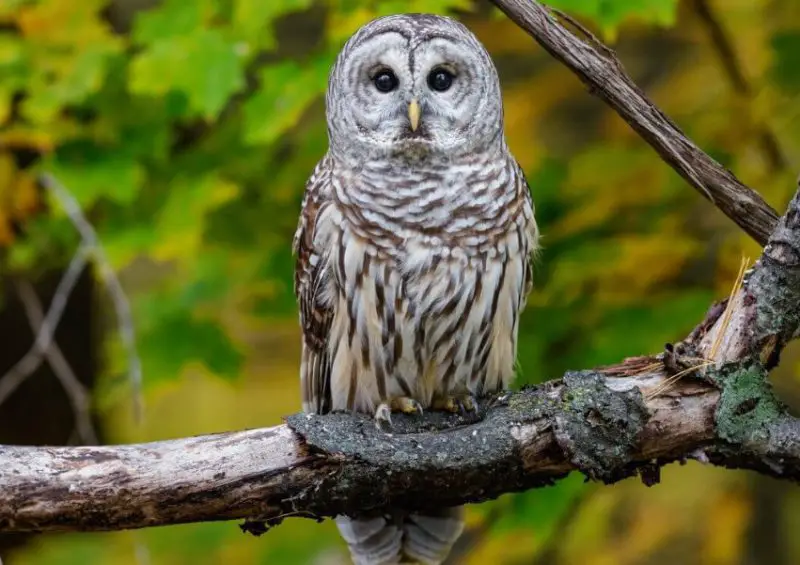
The Barred Owl is a large, stocky owl common in Virginia’s mature forests and wooded swamps. It has a round head without ear tufts, brown eyes, and distinctive horizontal barring on the chest with vertical streaks on the belly. Its signature “Who cooks for you? Who cooks for you all?” call is iconic and easily recognized.
Barred Owls measure about 16 to 25 inches in length with wingspans of 38 to 49 inches. They are nocturnal hunters, feeding on small mammals, birds, amphibians, and insects. Unlike some owls, they rely heavily on dense forest cover for nesting and roosting, often taking over abandoned nests of other large birds.
In Virginia, Barred Owls are year-round residents in forested areas, wetlands, and riparian zones. Their adaptability to various forest types allows them to coexist near suburban neighborhoods while maintaining stealthy hunting practices. Observing their vocalizations at dusk and dawn is a favorite activity for birdwatchers.
Eastern Screech-Owl
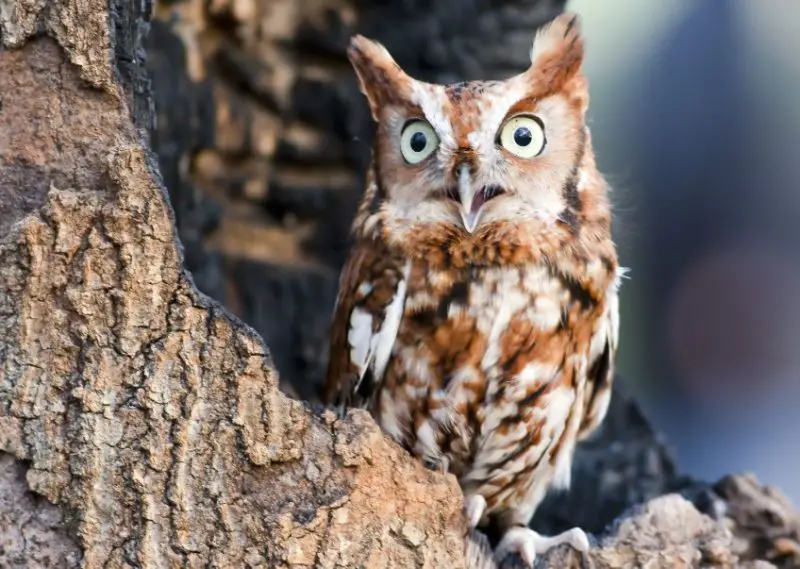
The Eastern Screech-Owl is a small, camouflaged owl common in Virginia’s forests, parks, and suburban areas. It has gray or reddish-brown plumage with intricate patterns that blend seamlessly with tree bark. Despite its name, its call is more of a trilling or whinnying sound rather than a scream.
These owls measure about 6 to 10 inches in length with wingspans of 18 to 24 inches. They are nocturnal predators, feeding on insects, small mammals, birds, and amphibians. Their small size allows them to nest in tree cavities or nest boxes, making them adaptable to suburban landscapes.
Eastern Screech-Owls are year-round residents in Virginia, often going unnoticed during the day due to their excellent camouflage. Their presence helps control populations of insects and small rodents, making them beneficial to humans. Nighttime observation, often by listening to their calls, provides a glimpse into the hidden nocturnal world of Virginia’s forests.
Killdeer
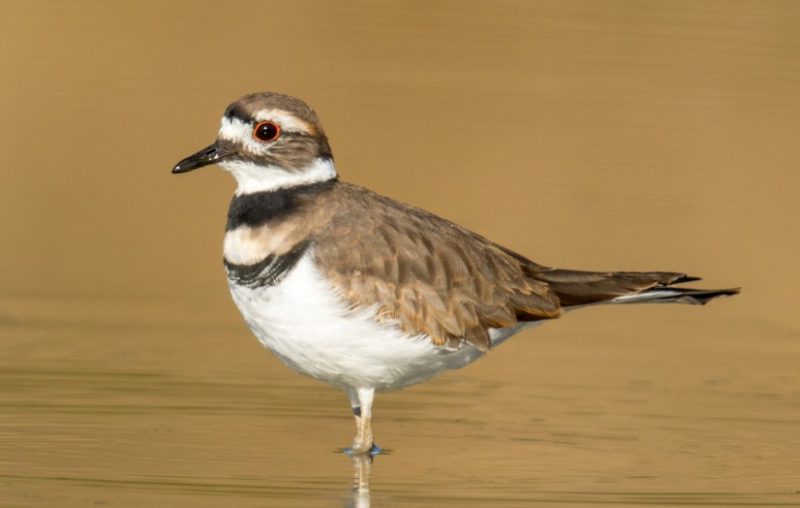
The Killdeer is a medium-sized shorebird easily recognized by its slender body, long legs, and distinctive double black breast bands. Its brown upperparts, white belly, and striking red eye-ring make it highly visible in open habitats. The Killdeer is famous for its “broken-wing” distraction display, used to lure predators away from nests.
Killdeer measure about 8 to 11 inches in length with wingspans of 18 to 20 inches. They are ground-nesting birds, often choosing gravelly or open areas, including fields, beaches, and lawns. Their loud, high-pitched “kill-deer” call is an unmistakable vocal signature, giving the species its name.
In Virginia, Killdeer are common migrants and summer residents, inhabiting open fields, shorelines, and pastures. They feed on insects, worms, and other invertebrates, often foraging by sight while running or walking quickly. Their bold behavior and striking markings make them a familiar sight to people exploring open habitats.
Rock Pigeon
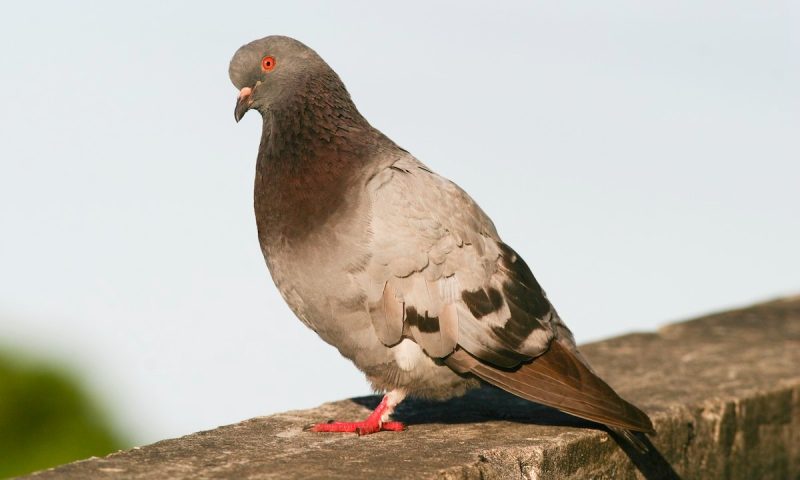
The Rock Pigeon is a familiar bird in Virginia, commonly seen in cities, towns, and farmland. Its plumage varies widely but often features shades of gray with iridescent green and purple on the neck. They have short legs, a rounded body, and a small head with bright orange eyes, making them easily identifiable in flocks.
Rock Pigeons measure about 11 to 14 inches in length with wingspans of 20 to 26 inches. They are strong fliers capable of sustained flight and rapid maneuvers. Their cooing calls and tendency to gather in large flocks make them highly noticeable in both urban and rural environments.
In Virginia, Rock Pigeons are year-round residents, thriving in areas modified by humans. They nest on building ledges, bridges, and cliffs, often using the same nesting sites for years. Their adaptability to diverse habitats and food sources, including human scraps, has made them one of the most widespread birds in the state.
Herring Gull

The Herring Gull is a large, robust gull commonly found along Virginia’s coasts, rivers, and lakes. Adults have light gray backs, white underparts, and pink legs, with yellow bills marked by a red spot on the lower mandible. Juveniles are mottled brown and take several years to develop full adult plumage.
These gulls measure about 22 to 26 inches in length with wingspans of 54 to 57 inches. They are strong fliers, often soaring or gliding over water in search of fish, invertebrates, and human-provided food. Their loud, raucous calls are a familiar sound near beaches, harbors, and landfill sites.
In Virginia, Herring Gulls are migratory, wintering along the coast and inland waterways. They are opportunistic feeders, adapting easily to human presence and varied food sources. Their social behavior often includes large, noisy flocks, particularly during the non-breeding season, making them a conspicuous part of the coastal landscape.
Ring-billed Gull
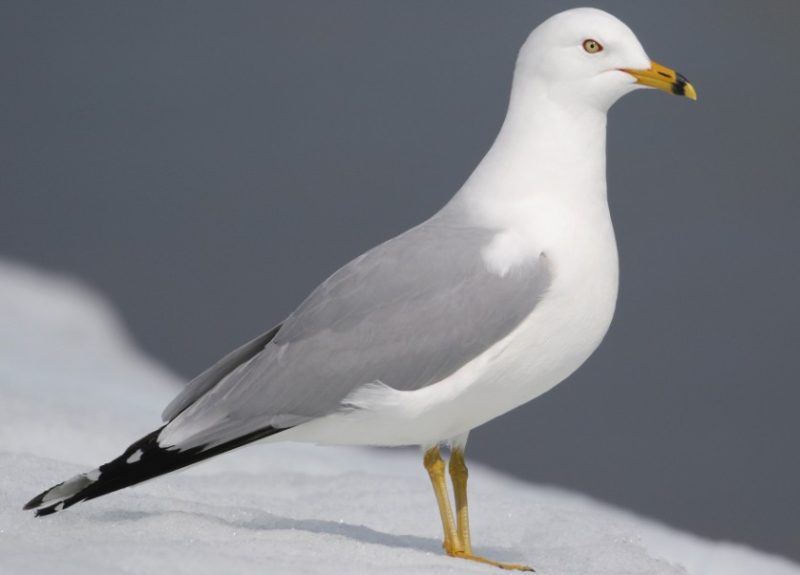
The Ring-billed Gull is a medium-sized gull commonly observed in Virginia near lakes, rivers, and coastal regions. Adults are mostly white with gray wings, black-tipped primaries, and a yellow bill marked with a distinctive black ring. Their eyes are pale, giving them a sharp, attentive expression.
These birds measure about 16 to 21 inches in length with wingspans of 41 to 46 inches. They are versatile feeders, often seen foraging along shorelines, parking lots, and garbage dumps, eating fish, insects, grains, and human food scraps. Their high-pitched, laughing calls are characteristic of gull colonies.
Ring-billed Gulls are migratory in Virginia, with most wintering along the coast or inland waterways. They are social and often form large flocks, sometimes mixing with other gull species. Their adaptability to human-altered landscapes and aggressive feeding habits make them a common sight in both urban and natural habitats.
Wood Duck
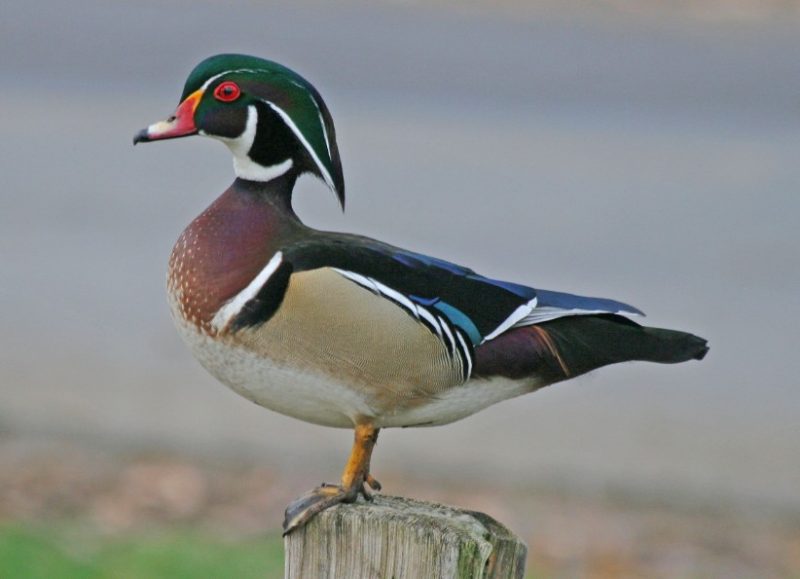
The Wood Duck is a strikingly colorful waterfowl native to Virginia, found in ponds, rivers, and wetlands with ample tree cover. Males are known for their iridescent green and purple head, red eyes, and ornate white patterns on the face and body, while females are brown with a white eye-ring and a subtle pattern on the breast.
Wood Ducks measure about 19 to 21 inches in length with wingspans of 26 to 29 inches. They are agile fliers and strong swimmers, often seen perching in trees near water. Their calls include high-pitched whistles and sharp “oo-eek” sounds, especially during courtship and territorial displays.
In Virginia, Wood Ducks nest in tree cavities near water and readily use nest boxes. They feed on seeds, fruits, insects, and aquatic plants. Their vivid plumage, acrobatic flight, and preference for wooded wetlands make them one of the most visually stunning and popular waterfowl species in the state.
Mallard
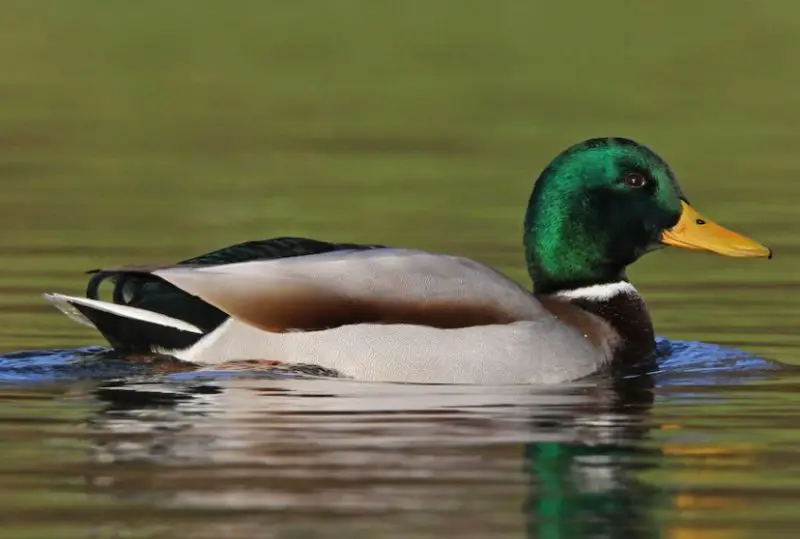
The Mallard is Virginia’s most common and widespread duck, easily recognized by the male’s glossy green head, yellow bill, and gray body, while females are mottled brown with an orange bill marked with black. Both sexes feature a blue speculum bordered by white on their wings, visible in flight.
These ducks measure about 20 to 26 inches in length with wingspans of 32 to 39 inches. They are versatile foragers, dabbling in shallow water for plants, insects, and small aquatic animals. Mallards are social, often forming large flocks, particularly in wintering areas or migration stopovers.
Mallards are year-round residents in Virginia, inhabiting ponds, rivers, wetlands, and even urban parks. They nest on the ground near water or in dense vegetation. Their adaptability to various habitats and diets, combined with their striking coloration, makes them a familiar and beloved species for both birdwatchers and hunters.
Wild Turkey
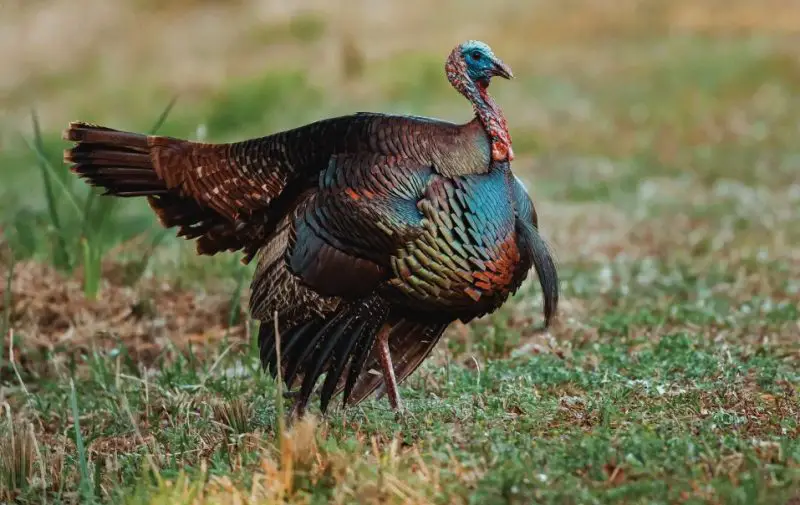
The Wild Turkey is a large, ground-dwelling bird native to Virginia’s forests and open fields. Males, or toms, are striking with iridescent bronze and green plumage, a bare red head, and a fan-shaped tail used in courtship displays, while females are more subdued in brown and gray tones for camouflage.
Wild Turkeys measure about 36 to 46 inches in length with wingspans of 50 to 66 inches. They are strong runners and capable fliers for short distances, often roosting in trees at night. Their deep gobbling calls, clucks, and drumming displays are key components of mating behavior and social interactions.
In Virginia, Wild Turkeys are year-round residents, thriving in forests, fields, and edges of woodlands. They feed on seeds, insects, nuts, and small fruits, often foraging in flocks. Their impressive size, social behavior, and elaborate courtship displays make them one of the most iconic and widely appreciated birds in the state.
FAQs About Common Birds in Virginia
What Are the Most Common Birds in Virginia?
Virginia hosts a diverse range of bird species. Some of the most common include the Northern Cardinal, American Robin, Blue Jay, Carolina Wren, Tufted Titmouse, and Mourning Dove. These birds are frequently seen in backyards, forests, and urban areas throughout the state.
When Is the Best Time to Observe Birds in Virginia?
The best time for birdwatching in Virginia is during spring and fall migrations, when many species pass through the state. Early mornings are ideal, as birds are most active and vocal. Summer and winter also provide opportunities, though species diversity may vary seasonally.
How Can I Identify Birds by Sight and Sound?
Birds can be identified by their size, plumage color, patterns, and behaviors, as well as their vocalizations. Field guides, mobile apps, and listening for distinctive calls like the Northern Mockingbird’s mimicking song or the Red-winged Blackbird’s “conk-la-ree” are helpful tools.
Where Do Common Virginia Birds Usually Live?
Different species prefer different habitats. For example, Wood Ducks and Mallards are often found near ponds and wetlands, Red-tailed Hawks inhabit forests and open fields, while House Sparrows and Rock Pigeons thrive in urban areas. Understanding habitat preferences helps with observation.
What Do Common Birds in Virginia Eat?
Diet varies by species. Songbirds such as the American Robin and Song Sparrow eat insects, seeds, and fruits. Raptors like Bald Eagles and Red-tailed Hawks feed on fish, small mammals, or other birds. Waterfowl like the Mallard and Wood Duck consume aquatic plants, insects, and small fish.
Are Any Common Birds in Virginia Threatened or Protected?
Many birds in Virginia are protected under the Migratory Bird Treaty Act, including Bald Eagles, Ospreys, and certain woodpeckers. While most common species are not endangered, habitat preservation and careful observation are important to maintain healthy populations.
Can I Attract These Birds to My Backyard?
Yes. Providing bird feeders, fresh water, native plants, and nesting boxes can attract many common Virginia species. Different birds prefer different foods: finches enjoy seeds, hummingbirds prefer nectar, and woodpeckers may use suet.

